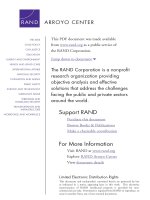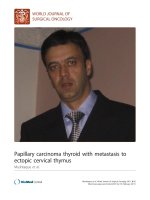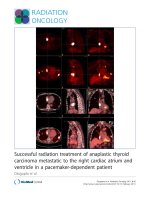Follicular thyroid carcinoma metastasis to the facial skeleton: A systematic review
Bạn đang xem bản rút gọn của tài liệu. Xem và tải ngay bản đầy đủ của tài liệu tại đây (1.06 MB, 8 trang )
Varadarajan et al. BMC Cancer (2017) 17:225
DOI 10.1186/s12885-017-3199-3
CASE REPORT
Open Access
Follicular thyroid carcinoma metastasis to
the facial skeleton: a systematic review
Varun V. Varadarajan1, Elizabeth K. Pace2, Vatsal Patel3, Raja Sawhney1, Robert J. Amdur4,5
and Peter T. Dziegielewski1,4*
Abstract
Background: Follicular thyroid carcinoma (FTC) metastasis to the facial skeleton is exceedingly rare. A case of FTC
metastasizing to the mandible is presented and a systematic review of the literature describing thyroid metastasis
to the facial skeleton is performed.
Case presentation: A 73-year-old female presented with metastatic FTC to the mandible and underwent total
thyroidectomy, segmental mandibulectomy, bone impacted fibular free flap reconstruction, and adjuvant radioactive
iodine treatment. The PubMed database was searched for literature describing thyroid cancer with facial skeleton
metastasis using the key words “thyroid,” “cancer,” “carcinoma,” “metastasis,” and “malignancy” with “oral cavity,” “maxilla,”
“mandible,” “sinus,” “paranasal,” and “orbit.” Reports that only involved the soft tissues were excluded. Systematic review
revealed 59 cases of well-differentiated thyroid cancer with facial skeleton metastasis: 35 mandibular metastases
(21 = FTC), 6 maxilla metastases (2 = FTC), 9 orbital metastases (4 = FTC), and 11 paranasal sinus metastases
(7 = FTC). Treatment included surgery, RAI, external beam radiotherapy (XRT), or a combination of these modalities.
The one, two, and five-year survival rates were 100%, 79%, and 16%, respectively.
Conclusion: Facial skeleton metastasis of FTC is a rare clinical challenge. Optimal treatment appears to include total
thyroidectomy and resection of involved structures with or without adjuvant treatment.
Keywords: Follicular thyroid carcinoma, Head and neck surgery, Endocrine surgery, Thyroid neoplasm
Background
Follicular thyroid carcinoma (FTC) is the second most
common thyroid carcinoma. It accounts for ~10% of thyroid malignancies, with a higher occurrence in women
aged 40–60 years [1]. Follicular thyroid carcinoma is
known to disseminate hematogenously and metastasize in
advanced cases. Distant metastases are seen in ~10–15%
cases, with bone and lungs as preferred metastatic targets
[2]. FTC metastases to the facial skeleton are exceedingly
rare and present a treatment challenge.
FTC facial bone metastasis can present in the gnathic
bones, the paranasal sinuses, or the orbit. Metastasis to
the facial skeleton may be the first clinical sign of an
* Correspondence:
Manuscript Presentation: This study was presented as a poster presentation
at the 9th International Conference on Head and Neck Cancer on July 17,
2016 in Seattle, Washington, USA.
1
Department of Otolaryngology (ENT), University of Florida, Gainesville, FL
32610, USA
4
University of Florida Health Cancer Center, Gainesville, FL, USA
Full list of author information is available at the end of the article
underlying malignancy and clinical presentation varies
depending on site of presentation as well as the primary
site [3–7]. Oral cavity and maxillofacial region metastasis
is uncommon and represent 1–2% of all oral and maxillofacial malignancies [3–5]. Prognoses of such lesions
are assumed to be poor; however, there is a paucity of
evidence to guide management of these scenarios.
In this report, a case of FTC metastasizing to the mandible is presented and a systematic review of the literature
is performed. The purpose is to describe the clinical
presentation, treatment, and survival outcomes of thyroid
metastasis to the facial skeleton.
Case presentation
A 73-year-old female patient was evaluated at the Head
and Neck Surgery Clinic at the University of Florida. Her
presenting complaint was numbness and swelling of her left
mandible and an intraoral lesion associated with recurrent
bleeding episodes. Symptoms were present for several
weeks and had initially been presumed to represent an
© The Author(s). 2017 Open Access This article is distributed under the terms of the Creative Commons Attribution 4.0
International License ( which permits unrestricted use, distribution, and
reproduction in any medium, provided you give appropriate credit to the original author(s) and the source, provide a link to
the Creative Commons license, and indicate if changes were made. The Creative Commons Public Domain Dedication waiver
( applies to the data made available in this article, unless otherwise stated.
Varadarajan et al. BMC Cancer (2017) 17:225
episode of sialadenitis by an outside provider. Her past
medical history was significant for a thyroid nodule and no
chronic medical conditions. She had no history of tobacco
or alcohol abuse. Physical exam demonstrated a left mandibular lesion approximately 5 cm in size, with fullness of
the gingival mucosa overlying the mass. A mucosal punch
biopsy was performed and the histology demonstrated a
pyogenic granuloma.
Computerized tomography (CT) showed an aggressive
mass destroying the mandibular body (Fig. 1) as well as
enlarged pulmonary nodules and a lytic bone lesion at
T10. Imaging also demonstrated a multinodular thyroid
gland with minimal irregularity along the anterior right
border. A 4.6 cm nodule was noted in the right thyroid
lobe. Fine needle aspiration of the right thyroid mass was
interpreted as a follicular lesion of undetermined significance (FLUS). Because the pathology findings were inconsistent with the CT scan, an open biopsy in the OR was
performed. A mucosal incision was made over the mass
and a biopsy was taken. The lesion was found to be extremely friable and bled significantly requiring ligation of
the facial artery. Final pathology demonstrated FTC.
Multidisciplinary tumor board review recommended
surgery followed by radioactive iodine and external beam
radiotherapy. The patient underwent total thyroidectomy,
neck dissection, segmental mandibulectomy, and boneimpacted fibular free flap reconstruction [6]. Intraoperative findings included a 10 cm thyroid mass of the right
thyroid lobe that extended beneath the sternum to the innominate vein. A segment of mandible was taken from left
angle to right parasymphysis, resulting in a defect from
Fig. 1 Preoperative computerized tomography depicting an aggressive
mass arising from the left mandible
Page 2 of 8
right lateral incisor to angle of mandible (Fig. 2).
Reconstruction was undertaken via a right bone-impacted
fibular free flap with skin paddle in addition to a 2.0 mm
mandibular reconstruction bar. Final pathology showed
mandibular metastasis of FTC with extension into the
tongue and soft tissues of the neck (Fig. 3). Margins were
negative. The 4.6 cm thyroid follicular carcinoma appeared to arise from a calcified pre-existing degenerative
follicular adenoma. There was evidence of capsular invasion and extensive lymphovascular invasion. The patient
underwent post-operative stereotactic body radiation to
the T-10 metastatic lesion and 200 mCi of radioactive
Iodine-131. She has been disease free for 18 months.
A systematic review of the English literature was
performed using PubMed, Medline, Embase, and Scopus
databases. Search terms describing FTC presenting as a
metastatic lesion in the facial skeleton were compiled and
implemented. These terms included: “thyroid,” “cancer,”
“thyroid carcinoma,” “thyroid cancer”, “metastasis,” and
“malignancy” with “oral cavity,” “maxilla,” “mandible,”
“sinus,” “paranasal,” and “orbit.” Papers were gleaned for
diagnoses of well-differentiated thyroid cancer, FTC, and
metastases to the facial skeleton. Reports of metastasis
that only involved the soft tissues were excluded. The
reports were organized by subsite: mandible, maxilla,
jawbone not otherwise specified, nasal cavity or paranasal
sinus, and orbit. Data points obtained from literature review included age, gender, primary oncologic diagnosis,
site of metastasis, clinical presentation, treatment modality, survival outcome, and time to follow-up were obtained. Statistical analysis was performed with SPSS 23.0
software package (SPSS Inc., Chicago, IL). Survival was
estimated by a Kaplan-Meier analysis to the account for
censored data. Survival by treatment was analyzed and
compared using the log rank test.
Literature review identified 64 studies reporting 97
cases of thyroid cancer metastasis to the facial skeleton
in the English literature. All metastases were present at
the time of presentation. 59 case reports specified welldifferentiated thyroid cancer as the diagnosis. Table 1
demonstrates details of these cases. 38 case reports did
Fig. 2 Left hemimandibulectomy specimen
Varadarajan et al. BMC Cancer (2017) 17:225
Page 3 of 8
Fig. 3 Photomicrograph of hematoxylin and eosin stain at 4X power depicting tumor cells infiltrating and destroying mandibular bone. Several
tumor cells are forming follicles characteristic of follicular carcinoma of the thyroid (blue arrows)
not specify the diagnosis and were not included [7–18].
The gender distribution was 9 males, 48 females, and 2
cases in which gender was not specified. While the majority of metastases were to the mandible, other craniofacial sites were also found to be involved.
Treatment varied between studies and included:
Surgery with or without preoperative embolization and
radioactive iodine therapy, external beam radiation
(primary or adjuvant treatment), and palliative chemotherapy. 22 patients were treated with surgery as initial
treatment with or without postoperative radioactive
iodine or external beam radiation. 11 patients were
treated with external beam radiation as primary treatment. 14 reports did not specify treatment. 4 patients
were treated with palliative care; 2 of these patients received palliative chemotherapy. Cases were grouped into:
a surgical arm (those treated with surgery and RAI) and
a non-surgical arm. 32 studies reported survival outcome
and 27 studies reported time-to-follow up. 24 patients
survived treatment and 8 patients expired.
Overall survival for all patients at 2 years was 96% and
at 5 years was 59%. Disease specific survival at 2 years
was 96% and at 5 years was 72%. Patients treated with
surgery and RAI versus those treated by non-surgical
means were compared. There was no statistical difference in overall survival (p = 0.27) with the surgical
group having 2 and 5 year overall survival of 100% and
71%, respectively and those in the non-surgical arm
having rates of 92% and 46%.
Disease specific survival for all patients at 2 years was
96% and at 5 years was 72% (Fig. 4). There was a statistically significant difference in disease specific survival
(DSS) between patients treated with surgery and RAI
versus those treated by non-surgical means (p = 0.03).
DSS for surgically treated patients at 2 and 5 years was
100% and for non-surgically treated patients was 92%
and 46%, respectively.
Discussion and conclusions
FTC is the second most common thyroid cancer, following papillary thyroid carcinoma (PTC). 10–15% of FTCs
will disseminate hematogenously via angioinvasion. The
most common sites of metastases include bone and lungs
and less commonly brain, liver, bladder, and skin. Bone
metastases can occur in the vertebral bodies followed by
the pelvis, femur, skull, and ribs [2, 19]. Treatment often
involves high dose radioiodine; however, bony metastases
are less likely to concentrate radioiodine, and thus, the
efficacy is estimated at 55%. External beam radiation therapy may be used for palliation [2].
Metastasis comprises 1% of all oral-maxillofacial malignancies. Primary sites of tumors metastatic to the
facial skeleton are most commonly from the breast and
lungs [20]. Thyroid malignancy represents 2% of facial
skeleton metastasis [20] and 4.2–6.1% of all jaw metastases [7, 15, 21] 41% of facial skeleton metastasis from thyroid cancer occurs in the mandible; 59% of these
metastases are well-differentiated thyroid cancer. There
have been 41 reported cases in the literature of thyroid
malignancy with metastasis to the mandible of which 21
reported cases were FTC [4, 9–12, 22–47]. There have
been 6 reported cases of metastasis to the maxilla; 2
were FTC [22, 48–52].
The majority of metastatic tumors to the mandible
present with facial swelling and an osteolytic lesion. A
rapid progression of intraoral or extraoral swelling associated with chin paresthesia and pain is not uncommon
[21, 29, 36, 53]. As the tumor invades oral mucosa, a
granulation-like mass may form and result in significant
bleeding, infection, fractures, and disturbances in
swallowing and mastication [32, 40].
Isolated facial skeleton metastasis may be treated with
surgical resection, radioactive iodine, external beam radiation or combinations of the three. The patient presented here was treated with a composite resection and
Varadarajan et al. BMC Cancer (2017) 17:225
Page 4 of 8
Table 1 List of reported cases of thyroid cancer metastasis to the facial skeleton
Author of
report
Age,
Primary Site of
Gender tumor
presentation
Clinical presentation
Treatment of
metastases
Survival Time to
follow-up
Agarwal et al. [26]
45, F
Facial swelling
Resection
Yes
FTC
Mandible
2 weeks
Algahtani et al. [40]
66, F
FTC
Mandible
Pathologic fracture
Resection
NR
NR
Anil et al. [72]
61, F
FTC
Mandible
Mandibular swelling
NR
NR
NR
Bhadage et al. [28]
40, F
FTC
Mandible
Facial swelling
NR, referred out
NR
NR
Bingol et al. [27]
33, F
PTC
Mandible
Painless mass of
mandibular angle
Surgery, RAI
No
5 years
Colella et al. [75]
50, F
PTC
Mandible
Pain and swelling in RMT
NR
NR
NR
Draper et al. [44]
NR, F
FTC
Mandible
Ulcerated oral lesion
XRT, RAI
NR
NR
Erdag et al. [23]
53, F
PTC
Mandible
Right sided facial swelling
Surgery, RAI
Yes
2.5 years
Essakalli et al. [41]
50, F
PTC
Mandible
Painful swelling of jaw
Resection, RAI
Yes
2 months
Germain et al. [42]
50, F
PTC
Mandible
Jugular, carotid
lymphadenopathy
Resection
Yes
17 months
Ismail et al. [30]
70, F
FTC
Mandible
Pain, “loose teeth”
NR
NR
NR
Kahn and
McCord [31]
82, F
FTC
Mandible
Painful oral swelling
XRT, surgical salvage
No
18
Kumar RVK
et al. [32]
58, F
FTC
Mandible
Painless facial swelling
Resection, mandible
reconconstructive bar,
second stage
thyroidectomy
Yes
2 years
Lavanya et al. [29]
76, M
FTC
Mandible
Painless mandibular
swelling
NR, referred out
NR
NR
Liu et al. [33]
66, M
PTC
Mandible
Cheek mass
Resection, RAI
Yes
3 years
Markitziu et al. [46]
69, F
PTC
Mandible
Facial swelling
XRT
Yes
18 months
McDaniel et al. [76]
77, F
FTC
Mandible
Pain, swelling
Resection, parotidectomy, Yes
RAI
4 years
Meyer and Shklar [3]
51, F
FTC
Mandible
NR
NR
NR
NR
Muttagi et al.:
2 cases [34]
NR
PTC
Mandible
NR
Surgery
NR
NR
NR
FTC
Mandible
NR
Surgery
NR
NR
Nishikawa et al. [39]
83, F
PDFTC
Mandible
Painful swelling of
jaw and face
None
No
19 months
Osguthorpe
and Bratton [35]
53, M
FTC
Mandible
Slowly enlarging parotid mass Resection, RAI
Yes
3 years
Ostrosky et al. [25]
72, M
FTC
Mandible
Painful vascular lesion
Resection, iliac crest graft
NR
NR
Pasupula et al. [36]
40, F
FTC
Mandible
Painful left parotid swelling
Resection
NR
NR
Tamiolakis et al. [4]
69, F
PTC
Mandible
Facial swelling, mucosal
ulcerations
Inoperable
NR
NR
Tovi et al. [47]
33, M
FTC
Mandible
Mimicking AVM
RAI
No
17 days
Vazifeh et al. [37]
58, F
FTC
Mandible
Facial swelling
Resection
NR
NR
Vishveshwaraiah
et al. [38]
56, F
FTC
Mandible
Painless facial swelling,
face and lip paresthesia
NR, referred out
NR
NR
Vural and
Hanna [24]
64, F
FTC
Mandible
Tender, pre-auricular
mass
Resection, post op
iodine ablation
Yes
6 weeks
Zandi et al. [11]
64, F
FTC
Mandible
NR
NR
NR
NR
75, F
FTC
Mandible
NR
NR
NR
NR
63, F
PTC
Mandible
NR
NR
NR
NR
44, F
PTC
Mandible
NR
NR
NR
NR
35, F
PTC
Mandible
NR
NR
NR
NR
51, F
PTC
Mandible
NR
NR
NR
NR
Varadarajan et al. BMC Cancer (2017) 17:225
Page 5 of 8
Table 1 List of reported cases of thyroid cancer metastasis to the facial skeleton (Continued)
Antunes et al. [22]
13, F
PTC
Maxilla
NR
NR
NR
NR
Fatahzadeh et al. [48] 43, F
PTC
Maxilla
Hemorrhagic mass with
ulceration and bleeding
XRT
NR
NR
Hefer et al. [52]
58, M
FTC
Maxilla
Left hard palate pain
Resection
Yes
2 years
Kumar CS et al. [51]
31, F
FTC
Maxilla
Painful swelling, mobile teeth
RAI
Yes
7 years
Nikitakis et al. [49]
63, M
PTC
Maxilla
Painful swelling of right
posterior maxilla
XRT, palliative
chemotherapy
Yes
2 years
Slim et al. [50]
67, F
PTC
Maxilla, zygoma
Painless malar swelling
Resection, postoperative
iodine ablation
Yes
NR
Cinberg et al. [64]
80, F
FTC
Maxillary sinus
Epistaxis
RAI
NR
NR
Altinay et al. [69]
68, F
FTC
Nasal Cavity, orbit,
skull base
Left eye puffiness, proptosis,
vision Loss, facial numbness
XRT
Yes
1 month
Malhotra et al. [60]
55, F
FTC
Orbit (Anterolateral
orbit)
Proptosis, vision Loss
Resection, RAI
NR
NR
Rocha Filho
et al. [57]
66, F
PTC
Orbit (Frontal bone)
Frontal bone mass
Palliative chemo
Yes
NR
BernsteinLipschitz et al. [55]
56, F
FTC
Orbit (Lacrimal fossa,
orbital roof)
Diplopia, ptosis, orbital Pain
Resection
NR
NR
Shyla et al. [54]
70, F
PTC
Orbit (Posterior orbit
Vision loss
extending to ethmoid
bone)
Resection, XRT
Yes
NR
Boughattas
et al. [56]
25, F
PTC
Orbit (Supraorbital)
Asymptomatic
NR
NR
NR
Daumerie et al. [58]
59, F
PTC
Orbit (Supratemporal
quadrant)
Left upper eyelid swelling,
exophthalmos
RAI
Yes
2 months
Pagsisihan
et al. [59]
49, F
PTC
Orbit (Supraorbital)
Supraorbital mass
RAI
Yes
6 months
Argibay-Vasquez [77]
53, F
PTC
Sphenoid
Headache, paresthesia in
the right eye region, left
monocular diplopia
RAI, subtototal resection,
XRT, RAI
Yes
3 years
Yamasoba et al. [67]
34, F
FTC
Ethmoid, sphenoid,
maxillary, intracranial
Cheek hypoesthesia,
hearing Loss
Embolization, resection
Yes
NR
Renner et al. [65]
61, F
FTC
Sphenoid sinus
Epistaxis, anosmia, visual loss
RAI, XRT
Yes
5 months
Barrs et al. [63]
54, F
FTC
Sphenoid sinus, orbit
Visual loss
RAI, XRT
No
5 years
Altman et al. [68]
81, M
FTC
Sphenoid, ethmoid,
skull base
Headache
XRT
No
1 year
Freeman et al. [78]
50, M
PTC
Sphenoid, ethmoid
Facial pain, proptosis of the
left globe, left horner’s
syndrome
XRT, RAI
Yes
1 year
Madronio et al. [79]
53, F
PTC
Sphenoid, ethmoid
Headache, galactorrhea,
vision loss
Surgical debulking
Yes
13 months
Cumberworth
et al. [66]
74, F
FTC
Sphenoid, frontal,
ethmoid, and
maxillary sinuses
Nasal obstruction
None
No
1 week after
diagnosis
FTC Follicular Thyroid Carcinoma, NR not reported, PTC Papillary Thyroid Carcinoma, RAI Radioactive Iodine Therapy, XRT External Beam Radiation Therapy
radioactive iodine. Her defect was reconstructed with a
bone-impacted osteocutaneous fibula free flap. Followup CT scanning demonstrated that the neo-mandible
retained a dense bone stock from the bone impaction.
Free flap reconstruction for metastatic thyroid cancer to
the mandible has only been reported once in the literature [42]. The current case is the first report of a boneimpacted fibular free flap used in this scenario.
Metastatic thyroid carcinomas are also reported in the
orbit and paranasal sinuses. 9 cases have been described
in the bony orbit; 4 of these were FTC [16, 54–61]. Surgical debulking of the metastatic foci may restore vision in
cases of sudden onset vision loss; radioiodine treatment
has also been documented as treatment for tumors that
uptake iodine. External beam radiation can also be an
option. There are 17 reported cases of thyroid malignancy
Varadarajan et al. BMC Cancer (2017) 17:225
Page 6 of 8
Fig. 4 Disease specific survival for patients with well-differentiated thyroid cancer metastatic to the facial skeleton treated with surgery as initial
treatment with adjuvant radioactive iodine therapy versus non-surgical treatment (external beam radiation)
presenting as a paranasal sinus mass (14.1%); 7 of these
cases were FTC [8, 13, 14, 17, 18, 62–69]. Two cases presented simultaneously in the paranasal sinus and the bony
orbit [63, 69]. Clinical manifestations include epistaxis,
nasal obstruction, visual disturbances, and facial or
intraoral swelling [70, 71]. The maxillary sinus is the most
commonly involved sinus followed by the sphenoid sinus,
ethmoid, and frontal sinus [70, 72]. The vertebral venous
plexus, which allows retrograde spread of tumor emboli,
could explain the etiology of paranasal sinus and orbital
metastasis [71, 73]. Craniofacial resection or debulking
with or without preoperative vascular embolization can be
considered, however, the proximity of the metastatic
tumor to the skull base may preclude surgical extirpation
[59, 67, 69]. Radioiodine therapy, external beam radiation,
chemotherapy, or palliative therapy can be considered in
these patients [57, 59, 68, 74].
Survival analysis suggests that surgical resection of involved craniofacial structures with or without adjuvant
treatment is the optimal treatment for FTC metastatic to
the facial bones. Given the rarity of the condition, the
sample size is limited; however, survival analysis demonstrated convincing statistically significant advantages with
surgical resection. Treatment plans should be formulated
with a multidisciplinary team involving surgical oncology,
radiology, pathology, endocrinology, medical oncology,
radiation oncology, and possibly palliative care.
In conclusion, facial skeleton metastasis of FTC is a
rare clinical challenge. If feasible, surgical-based treatment options offer the best survival outcomes. When
mandibular defects are present, reconstruction with a
bone impacted fibular free flap may provide a reconstruction with a robust bone stock.
Abbreviations
CT: Computerized tomography; FTC: Follicular thyroid carcinoma; NR: Not
reported; PTC: Papillary thyroid carcinoma; RAI: Radioactive iodine therapy;
XRT: External beam radiation therapy
Acknowledgements
The authors have no acknowledgements.
Funding
The authors of this study declare no sources of funding for this study.
Availability of data and materials
All data generated or analyzed during this study are included in this published
article.
Authors’ contribution
VV participated in the design of the study, data collection, participated in
statistical analysis, and drafted the manuscript. EP participated in data
collection, statistical analysis, and in drafting the manuscript. VP participated
in data collection, histopathology interpretation, and drafting the manuscript.
RS participated in the design of the study and in conceiving the study. RA
participated in critically revising the manuscript for important intellectual
content. PD conceived and designed the study, performed statistical analysis,
and revised the manuscript critically for important intellectual content.
All authors read and approved the final manuscript.
Varadarajan et al. BMC Cancer (2017) 17:225
Authors’ information
VV is an Otolaryngology –Head and Neck Surgery resident physician at the
University of Florida in Gainesville, Florida. EP is a senior medical student at
the University of Florida College of Medicine in Gainesville, Florida. VP is a
Pathology resident physician at the University of Florida in Gainesville,
Florida. RS is an Assistant Professor in the University of Florida Department of
Otolaryngology – Division of Facial Plastic Surgery in Gainesville, Florida. RA
is a Professor in the University of Florida Department of Radiation Oncology.
PD is an Assistant Professor at the University of Florida Department of
Otolaryngology and Chief of the Division of Head and Neck Oncologic
Surgery in Gainesville, Florida.
Competing interests
The authors of this study manuscript declare that they have no competing
interests.
Consent for publication
Written informed consent was obtained from the patient for publication of
this Case report and any accompanying images.
Ethics approval and consent to participate
Ethics approval was not necessary for this study and manuscript due to the
type of study design (Case Report, Literature Review). All patient data and
photographs are de-identified.
Publisher’s Note
Springer Nature remains neutral with regard to jurisdictional claims in
published maps and institutional affiliations.
Author details
1
Department of Otolaryngology (ENT), University of Florida, Gainesville, FL
32610, USA. 2University of Florida College of Medicine, Gainesville, FL, USA.
3
Department of Pathology, University of Florida, Gainesville, FL, USA.
4
University of Florida Health Cancer Center, Gainesville, FL, USA. 5Department
of Radiology, University of Florida, Gainesville, FL, USA.
Received: 30 November 2016 Accepted: 15 March 2017
References
1. D’Avanzo A, Treseler P, Ituarte PHG, Wong M, Streja L, Greenspan FS, et al.
Follicular thyroid carcinoma: histology and prognosis. Cancer. 2004;100:1123–9.
2. McHenry CR, Phitayakorn R. Follicular adenoma and carcinoma of the
thyroid gland. Oncologist. 2011;16:585–93.
3. Meyer I, Shklar G. Malignant tumors metastatic to mouth and jaws. Oral
Surg Oral Med Oral Pathol. 1965;20:350–62.
4. Tamiolakis D, Tsamis I, Thomaidis V, Lambropoulou M, Alexiadis G, Venizelos
I, et al. Jaw bone metastases: four cases. Acta Dermatovenerol Alp Panonica
Adriat. 2007;16:21–5.
5. Brucoli M, Arcuri F, Stellin L, Benech A. Zygomatic metastasis from breast
cancer. J. Craniofac. Surg. 2010;21:2012–4.
6. Dziegielewski PT, Mlynarek AM, Harris JR, Hrdlicka A, Barber B, Al-Qahtani K,
et al. Bone impacted fibular free flap: a novel technique to increase bone
density for dental implantation in osseous reconstruction. Head Neck 2013
7. Batsakis J. Tumors of the head and neck: clinical and pathological considerations.
2nd ed. Baltimore: Williams & Wilkins; 1979.
8. DeVincentiis I. Sulle metastasi del cancro tiroideo di interesse otorhinolayngoiatrico.
Ann di Laringol Otol Rinol Farinologia. 1959;33:39–48.
9. Kaveri H. VA Punnya TA. Metastatic thyroid carcinoma to the mandible.
J Oral Maxillofac Path. 2007;11:32–4.
10. Mahtar M, Kadiri F, Detsouli M, Raji A, Idrissi Chekkoury A, Benchakroun Y.
[Mandibular metastasis revealing thyroid carcinoma. Two cases]. Rev. Stomatol.
Chir. Maxillofac. 2002;103:120–3.
11. Zandi M, Jafari M, Isapour M, Jafari AA. Mandibular metastasis in a patient
with undiscovered synchronous thyroid and prostate cancer: a diagnostic
dilemma. J Oral Maxillofac Pathol. 2014;18:449–52.
12. Ripp GA, Wendth AJ, Vitale P. Metastatic thyroid carcinoma of the mandible
mimicking an arteriovenous malformation. J Oral Surg. 1977;35:743–5
13. Bataille R, Schuhmann C, Rolland J. Sinusal metastasis from a thyroid
epithelioma. Rev Stomatol Chir Maxillofac. 72:129–31.
Page 7 of 8
14. Auriti F. Adenoma struttura tiroidea del setto nasale. Arch Ital di Laryngol.
1921;4:120–7.
15. Hirshberg A, Shnaiderman-Shapiro A, Kaplan I, Berger R. Metastatic tumours
to the oral cavity – pathogenesis and analysis of 673 cases. Oral Oncol.
2008;44:743–52.
16. Betharia SM. Metastatic orbital carcinoma of thyroid. Indian J Ophthalmol.
33:191–3.
17. Chang G, Weber A, Pappanikou A. X-ray study of the month. Metastatic
carcinoma of the thyroid to the sphenoid sinus. Ann Otol RhinolLaryngol.
1983;92:309–10.
18. Von Eiselberg A. Uber knochen-metastasen des schilddrusen krebses verhandl.
Deutsch Gesellchraft fur Chir. 1893;22
19. Cooper DS, Doherty GM, Haugen BR, Hauger BR, Kloos RT, Lee SL, et al. Revised
American Thyroid Association management guidelines for patients with
thyroid nodules and differentiated thyroid cancer. Thyroid. 2009;19:1167–214.
20. Friedrich RE, Abadi M. Distant metastases and malignant cellular neoplasms
encountered in the oral and maxillofacial region: analysis of 92 patients
treated at a single institution. Anticancer Res. 2010;30:1843–8.
21. Hirshberg A, Berger R, Allon I, Kaplan I. Metastatic tumors to the jaws and
mouth. Head Neck Pathol. 2014;8:463–74.
22. Antunes AA, Antunes AP. Gnathic bone metastasis: a retrospective study of
10 cases. Braz J Otorhinolaryngol. 2008;74:561–5.
23. Erdag T, Bilgen C, Ceryan K. Metastatic thyroid carcinoma of the mandibule.
Rev Laryngol Otol Rhinol (Bord). 1999;120:31–4.
24. Vural E, Hanna E. Metastatic follicular thyroid carcinoma to the mandible: a
case report and review of the literature. Am J Otolaryngol. 1998;19:198–202.
25. Ostrosky A, Mareso EA, Klurfan FJ, Gonzalez MJ. Mandibular metastasis of
follicular thyroid carcinoma. Case report Med Oral. 2003;8:224–7.
26. Agarwal A, Mishra SK, Jain M. Follicular thyroid carcinoma with metastasis to
the mandible. J Indian Med Assoc. 1998;96:354–5.
27. Bingol UA, Cinar C, Cetinkale O. Mandibular metastases of papillary thyroid
carcinoma treated by hemimandibulectomy and costochondral rib graft.
Plast Reconstr surgery Glob open. 2015;3:e305.
28. Bhadage CJ, Vaishampayan S, Umarji H. Mandibular metastasis in a patient
with follicular carcinoma of thyroid. Contemp Clin Dent. 2012;3:212–4.
29. Lavanya C, Ranganathan K, Veerabahu M. Mandibular metastasis of thyroid
carcinoma: a case report. J Clin Diagn Res. 2014;8:ZD15–6.
30. Ismail S. Bin, Abraham MT, Zaini ZB, Yaacob H Bin. Zain RB Case report Metastatic
follicular thyroid carcinoma to the mandible : a case report. 2009;3:3–5.
31. Kahn MA. Mccord PT. Metastatic Thyroid Carcinoma of the Mandible : Case
Report. 1989:1314–6.
32. Kumar RVK, Chakravarthy C, Sekhar GR, Devireddy SK, Kumaravelu C, Kare A.
Metastatic thyroid carcinoma presenting as Hypervascular lesion of the
mandible: a case report and review of literature. J Oral Maxillofac Surg.
2010;68:2613–6. Available from: />S027823910901934X
33. Liu L, Venkataraman G, Salhadar A. Follicular variant of papillary thyroid
carcinoma with unusual late metastasis to the mandible and the scapula.
Pathol Int. 2007;57:296–8. Available from: />1440-1827.2007.02092.x
34. Muttagi S, D’Cruz A, Chaukar D, Singh B, Chaturvedi P, Kane S, et al.
Metastatic tumors to the jaw bones: retrospective analysis from an Indian
tertiary referral center. Indian J Cancer 2011;48:234. Available from: http://
www.indianjcancer.com/text.asp?2011/48/2/234/82894
35. Osguthorpe JD, Bratton JR. Occult thyroid carcinoma appearing as a single
mandibular metastasis. Otolaryngol. Head Neck Surg. 1982;90:674–5.
36. Pasupula AP, Dorankula SPR, Thokala MR, Kumar MP. Metastatic follicular
thyroid carcinoma to the mandible. Indian J. Dent. Res. 23:843.
37. Vazifeh Mostaan L, Irani S, Rajati M, Memar B. Mandibular metastasis from follicular
thyroid carcinoma: a rare case after twelve years. Arch Iran Med. 2013;16:557–9.
38. Vishveshwaraiah PM, Mukunda A, Laxminarayana KK, Kasim K. Metastatic
follicular thyroid carcinoma to the body of the mandible mimicking an
odontogenic tumor. J Cancer Res Ther. 9:320–3.
39. Nishikawa H, Nakashiro K, Sumida T, Sugita A, Hamakawa H. Mandibular
osteoblastic metastasis of poorly differentiated carcinoma of the thyroid
gland. Int. J. Oral Maxillofac. Surg. [internet]. 2010;39:301–4. Available from.
/>40. Algahtani M, Alqudah M, Alshehri S, Binahmed A, Sándor GKB. Pathologic
fracture of the mandible caused by metastatic follicular thyroid carcinoma.
J Can Dent Assoc. 2009;75:457–60. Available from: .
gov/pubmed/19627656
Varadarajan et al. BMC Cancer (2017) 17:225
41. Essakalli L, Jazouli N, Kzadri M. [Mandibular metastasis disclosing a papillary
carcinoma of the thyroid gland]. Rev. Stomatol. Chir. Maxillofac. 1994;95:351–4.
42. Germain MA, Marandas P, Leridant AM, Domenge C, Julieron M,
Schlumberger M, et al. Isolated mandibular metastasis of cancer of the
thyroid. Mandibulectomy and reconstruction using a free vascularized
peroneal graft. Rev Stomatol Chir Maxillofac. 1998;98:371–4.
43. Sirichitra V. Follicular thyroid carcinoma metastasizing to the mandible (case
report). J Dent Assoc Thai. 1981;31:75–83.
44. Draper BW, Precious DS, Priddy RW, Byrd DL. Clinicopathological conference.
Case 29, part 2. Follicular thyroid carcinoma metastatic to the mandible. J. Oral
Surg. 1979;37:736–9.
45. Parichatikanond P, Parichatikanond P, Damrongvadha P, Kompairoj C,
Chaovanapricha K. Jaw metastasis from follicular carcinoma of thyroid gland
simulating ameloblastoma. J Med Assoc Thail. 1984;67:362–7.
46. Markitziu A, Fisher D, Marmary Y. Thyroid papillary carcinoma presenting
as jaw and parotid gland metastases. Int J Oral Maxillofac Surg. 1986;15:648–53.
47. Tovi F, Leiberman A, Hirsch M. Uncommon clinical manifestations in a case
of thyroid carcinoma. Head Neck Surg. 6:974–7.
48. Fatahzadeh M, Subramanian MSDG. Singer SR. Metastatic papillary thyroid
carcinoma to maxilla : A rare case. 2015;46:431–5.
49. Nikitakis NG, Polymeri A, Polymeris A, Sklavounou A. Metastatic papillary
thyroid carcinoma to the maxilla: case report and literature review. Head
Neck Pathol. 2012;6:216–23. Available from: .
gov/articlerender.fcgi?artid=3370027&tool=pmcentrez&rendertype=abstract
50. Slim I, Mhiri A, Meddeb I, Goucha A, Gritli S, Ben Slimene MF. Malar bone
metastasis revealing a papillary thyroid carcinoma. Case Rep Otolaryngol.
2012;2012:795686.
51. Kumar CS, Shanmugam D, Venkatapathy R, Munshi MAI. Metastatic follicular
carcinoma of thyroid in maxilla. Dent Res J (Isfahan). 2013;10:817–9.
52. Hefer T, Manor R, Zvi Joachims H, Groisman GM, Peled M, Gov-Ari E, et al. Metastatic
follicular thyroid carcinoma to the maxilla. J Laryngol Otol. 1998;112:69–72.
53. Murillo J, Bagan JV, Hens E, Diaz JM, Leopoldo M. Tumors metastasizing to
the oral cavity: a study of 16 cases. J Oral Maxillofac Surg. 2013;71:1545–51.
Available from: />54. Shyla PR, Nair RM, Somanathan T. Rare case of orbital tumor. Indian J.
Otolaryngol. Head Neck Surg. 2007;59:174–5. Available from: http://www.
ncbi.nlm.nih.gov/pubmed/19727568
55. Bernstein-Lipschitz L, Lahav M, Chen V, Gutman I, Gal R, Lipschitz M. Metastatic
thyroid carcinoma masquerading as lacrimal gland tumor. Graefes Arch Clin
Exp Ophthalmol. 1990;228:112–5.
56. Boughattas S, Chatti K, Degdegui M, Bouslama Z, Elaouni C. Uncommon case
of orbital metastasis secondary to papillary thyroid carcinoma. Thyroid. 2005;15:
1311–2. Available from: />57. Rocha Filho FD, Lima GG, Ferreira FV, de A, Lima MG, Hissa MN. Orbital
metastasis as primary clinical manifestation of thyroid carcinoma–case
report and literature review. Arq. Bras. Endocrinol. Metabol. 2008;52:1497–
500. Available from: />58. Daumerie C, De Potter P, Godfraind C, Rahier J, Jamar F, Squifflet JP. Orbital
metastasis as primary manifestation of thyroid carcinoma. Thyroid.
2000;10:189–92.
59. Pagsisihan DA, Aguilar AHI, Maningat MPDD. Orbital metastasis as initial
manifestation of a widespread papillary thyroid microcarcinoma. BMJ Case
Rep. 2015;2015 Available from: />25819821
60. Malhotra G, Upadhye TS, Menon S, Asopa RV, Laskar SG, Pawar S, et al.
Unilateral proptosis due to orbital metastasis as a presenting clinical
manifestation of carcinoma of the thyroid. Clin Nucl Med. 2010;35:362–5.
Available from: />61. Tijl J, Koornneef L, Eijpe A, Thomas L, Gonzalez DG, Veenhof C. Metastatic
tumors to the orbit–management and prognosis. Graefes Arch Clin Exp
Ophthalmol. 1992;230:527–30.
62. Harmer L. Schilddrusenmetastase in der Nasenhohle. Weiner Klin Wochenschrift.
1899;23:628–31.
63. Barrs DM, McDonald TJ, Whisnant JP. Metastatic tumors to the sphenoid
sinus. Laryngoscope. 1979;89:1239–43.
64. Cinberg JZ, Terrife D. Follicular adenocarcinoma of the thyroid in the maxillary
sinus. Otolaryngol Head Neck Surg. 1979;88:157–8.
65. Renner GJ, Davis WE, Templer JW. Metastasis of thyroid carcinoma to the
paranasal sinuses. Otolaryngol - Head Neck Surg. 1984;92:233–7.
66. Cumberworth VL, Ohri A, Morrissey G, Stirling R. Late sino-nasal metastasis
from follicular thyroid carcinoma. J Laryngol Otol. 1994;108:1010–1.
Page 8 of 8
67. Yamasoba T, Kikuchi S, Sugasawa M, Higo R, Sasaki T. Occult follicular
carcinoma metastasizing to the sinonasal tract. ORL J Otorhinolaryngol Relat
Spec. 56:239–43.
68. Altman KW, Mirza N, Philippe L. Metastatic follicular thyroid carcinoma to the
paranasal sinuses: a case report and review. J Laryngol Otol. 1997;111:647–51.
69. Altinay S, Taskin U, Aydin S, Oktay MF, Ozen A, Ergul N. Metastatic follicular
thyroid carcinoma masquerading as olfactory Neuroblastoma: with SkullBase, cranium, Paranasal sinus, lung, and diffuse bone metastases. J Craniofac
Surg. 2015;26:E3–6.
70. Prescher A, Brors D. Metastases to the paranasal sinuses: case report and
review of the literature. Laryngorhinootologie. 2001;80:583–94. Available
from: />71. Krishnamurthy A, Vaidhyanathan A, Krishna KR. Metastasis of follicular
thyroid carcinoma to the maxillary sinus. Indian J Nucl Med. 2010;25:168–70.
Available from: />72. Anil S, Lal PM, Gill DS, Beena VT. Metastasis of thyroid carcinoma to the
mandible. Case report. Aust Dent J. 1999;44(1):56-57.
73. Nahum AM, Bailey BJ. Malignant tumors metastatic to the Paranasal sinuses:
case report and review of the literature. Laryngoscope. 1963;73:942–53.
Available from: />74. López F, Devaney KO, Hanna EY, Rinaldo A, Ferlito A. Metastases to nasal
cavity and paranasal sinuses. Head Neck. 2016;38(12):1847–54.
75. Colella G, Capone R, Cappabianca S. Mandibular metastasis from papillary
thyroid carcinoma–a case report. Tumori. 2003;89(4):452-454.
76. McDaniel RK, Luna MA, Stimson PG. Metastatic tumors in the jaws. Oral
Surgery, Pral Med Oral Pathol. 1971;31(3):380-386.
77. Argibay Vázquez S, Lancha Hernández C, Martínez Muñiz A. Metastases in
the sphenoidal sinus in a patient with papillary thyroid cancer. Clin Transl
Oncol. 2005;7(7):324-327.
78. Freeman JL, Gershon A, Liavaag PG, Walfish PG. Papillary thyroid carcinoma
metastasizing to the sphenoid-ethmoid sinuses and skull base. Thyroid.
1996;6(1):59-61.
79. Madronio EB, Lantion-Ang FL. The tale of two tumours: an undiagnosed
case of papillary thyroid carcinoma. BMJ Case Rep. 2011;2011:1-6.
Submit your next manuscript to BioMed Central
and we will help you at every step:
• We accept pre-submission inquiries
• Our selector tool helps you to find the most relevant journal
• We provide round the clock customer support
• Convenient online submission
• Thorough peer review
• Inclusion in PubMed and all major indexing services
• Maximum visibility for your research
Submit your manuscript at
www.biomedcentral.com/submit









